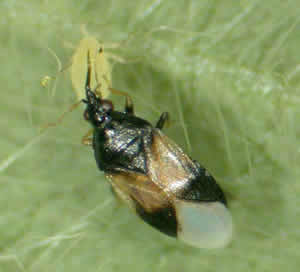What's eating aphids? Two bugs farmers should know
By Steve Leer
Ag Communications
November 10, 2006
 |
Orius insidiosus adult attacking soybean aphid
by Ho Jung Yoo |
WEST LAFAYETTE, Ind. - Farmers could save $10-$12 per acre on insecticide treatments for soybean aphids by turning to a control method that money can't buy, said a Purdue University entomologist.
That control option, said Bob O'Neil, is the aphid's insect enemies.
Research by O'Neil, fellow Purdue entomologists and entomology colleagues at four other Midwest land-grant universities found that in most cases predators are able to consume enough aphids to keep aphid populations below crop-damaging levels. The multi-state research project has been ongoing since 2003.
"We did several studies in which we isolated soybean aphids away from their predators," O'Neil said. "We built small screen cages and put soybean aphids inside them. There were similar numbers of soybean aphids outside the cage on plants.
"What we found was that the population size of soybean aphids inside the cage increased four times, whereas outside the cage aphid numbers typically decreased.
"Outside the cage, the natural predators were reducing the aphid population. When we protected the soybean aphids, those populations grew. That told us that these natural predators were important and that farmers need to pay attention to them."
Aphids have been a problem for farmers since the pinhead-size yellow-green insects were first found in United States soybean fields in 2000. Major aphid infestations have occurred in odd-numbered years - a phenomenon that researchers don't fully understand.
Aphids damage soybeans by injecting their needlelike mouthpart into a plant's leaves and extracting sap, limiting the plant's ability to produce seeds. The insect's rapid reproduction - it can birth as many as 15 generations in a single crop season - makes the aphid a dangerous pest.
Yield losses of up to 30 percent have been reported in some areas. The aphid already has caused an estimated $500 million in crop damage in the United States, O'Neil said.
"We've estimated that Indiana farmers spent more than $7 million to control the soybean aphid in the 2003 outbreak," O'Neil said. "By far, the soybean aphid is the most damaging insect we've ever had in soybeans."
O'Neil and his research team examined aphid predators and their feeding patterns, and discovered that predators are present throughout the critical phases of soybean development.
"There's quite a few predators in soybeans, but when you take a look at who is out there, in what numbers and who is having a major impact, it comes down to a few species doing the heavy lifting," O'Neil said. "Early in the season there's a predatory bug called the insidious flower bug, also known as the minute pirate bug. That particular insect is important when there are relatively few numbers of soybean aphids in the field.
"Later in the season - in August and into September - when soybean aphid populations are higher, there's another set of predators that come in. These tend to be the predatory beetles. One of them is the Asian lady beetle and it does a great job. So between the minute pirate bug and the lady beetle, you've got a kind of one-two punch."
Pirate bugs eat up to eight aphids per day, O'Neil said. The lady beetles consume 30 to 40 a day, he said.
Between the two predators, aphid populations often stay below significant yield loss - or "economic threshold" - levels, O'Neil said.
"The economic threshold is 263 aphids per plant," he said. "We round that to 250 because it is a bit easier to work with.
"It's really important for farmers to know that bit of information. They also should know that just because you have soybean aphids in your field doesn't mean that you have a pest problem in your field. If you don't get to that threshold level the soybean aphids are just living out there - they're not doing any damage and it is not worth the cost of control."
Not only could farmers be spending money needlessly on insecticides but also reducing the predator population, O'Neil said.
"By spraying too early or at times when they shouldn't be spraying, farmers can be destroying these natural predators," he said. "It's sort of akin to taking the bank guard out of the bank. It's just not something that you want to do, unless you really have to treat that field."
Researchers next hope to determine how many predators per soybean plant are necessary to keep aphid populations from reaching the economic threshold. Until then, O'Neil encouraged soybean farmers to become familiar with the minute pirate bug and Asian lady beetle.
"They need to be able to identify their friends as well as their enemies in the soybean field," O'Neil said.
A Web site created from the aphid research can help farmers do just that. The Soybean Aphid Biological Control site is online. The Web site is the collaborative effort of Purdue, Iowa State and Michigan State universities; the universities of Illinois, Minnesota and Wisconsin; the Illinois Natural History Survey; and the U.S. Department of Agriculture. It is supported by a grant from the North Central Soybean Research Program.
The Purdue research also is supported by the Indiana Soybean Board and USDA.
Additional information on soybean aphids and other crop insects is available on the Purdue entomology field crops Web page
Writer: Steve Leer, (765) 494-8415, sleer@purdue.edu
Source: Bob O'Neil, (765) 494-7207, rjoneil@purdue.edu
Ag Communications: (765) 494-2722;
Beth Forbes, forbes@purdue.edu
Agriculture News Page |